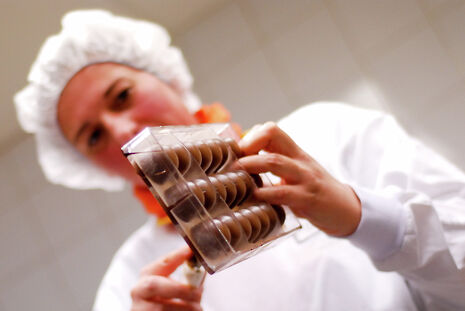The chemistry of chocolate
Zi Ran Shen explores the sweet taste of crystallography

Those who know me well have often been treated to my impassioned speech about how overwhelmingly sweet chocolates are. I’ve often refused chocolate desserts, ice-cream, and confectionery, citing my boredom with their overuse while choosing their fruity counterpart. Though my culinary experience with them has been less than thrilling, my scientific relationship with this substance is nothing short of magical.
As anyone that has looked at a chocolate label knows, chocolate consists of various ratios of cocoa butter, cocoa solids, sugar, and milk. Though the ingredients seem simple, good chocolate which delivers both a crunch and the melt-in-your-mouth feeling excites almost everyone. The silky texture of chocolate is unrivalled in the food landscape, as is its versatility. Chocolate combines with cream to make a buttery ganache, dissolves in milk to form a rich drink, and shaves into beautiful ribbons. Its transformations earned chocolate the crown in the dessert world. At the heart of chocolate’s many forms lies a cutting-edge scientific technique: crystallography.
“These properties have cemented chocolate’s place in the culinary scene as a regular showstopper”
Crystallography is the art of growing ordered molecular lattices. In biology, scientists aim to grow crystals of macromolecules such as proteins, or RNA. Confectioners instead aim to grow crystals of fat. Cocoa butter contains many fats that can crystallise at different temperatures, in a total of six forms. The most desired crystal form is crystal V, which melts the closest to body temperature and has the best snap. To create such a crystal, confectioners must align the molecules by giving the melted chocolate enough energy so that the lower-stability crystals don’t form, but crystal V is able to. This process begins at around 31ºC. When microcrystals have formed, the rest of the molecules soon snap into place, creating the perfect tempered chocolate.
The crystal lattice gives chocolate its unique properties. Unlike other solid fats (think cheese, butter, and lard), cocoa butter is brittle. It snaps under pressure instead of being moulded. Crystals, while strong as a whole, will snap if a fracture is formed. One small molecular break will separate the whole crystal in two. Also, other fats melt at an even rate. From runny oil to solid butter, there is a soft stage in between. Chocolate does not have that stage. As soon as that solid chunk of chocolate enters your mouth, it melts into a velvety liquid. Crystals are different from other solids in that it forms select molecular contacts, whereas solids are very compact. A little extra energy in the form of heat can quickly disassemble a crystal lattice while barely putting a dent into melting an otherwise disordered solid. Though unique, chocolate’s crystals are easy to combine with other foods. Since the crystals are made from fat and melt at around body temperature, it readily incorporates into butter, milk, or cakes. All of these properties have cemented chocolate’s place in the culinary scene as a regular showstopper.
No matter how much I pretend that chocolate is too sweet or overused, I cannot ignore their scientific brilliance. When solid chocolate was invented in 1847, the field of crystallography had only started making its first steps — the Miller indices used to catergorise crystals were just developed. The art of chocolate tempering and its science have developed side by side to present the multitude of forms of chocolate sold today
 News / Fitz students face ‘massive invasion of privacy’ over messy rooms23 April 2024
News / Fitz students face ‘massive invasion of privacy’ over messy rooms23 April 2024 News / Cambridge University disables comments following Passover post backlash 24 April 2024
News / Cambridge University disables comments following Passover post backlash 24 April 2024 Comment / Gown vs town? Local investment plans must remember Cambridge is not just a university24 April 2024
Comment / Gown vs town? Local investment plans must remember Cambridge is not just a university24 April 2024 Comment / Does Lucy Cavendish need a billionaire bailout?22 April 2024
Comment / Does Lucy Cavendish need a billionaire bailout?22 April 2024 Interviews / Gender Agenda on building feminist solidarity in Cambridge24 April 2024
Interviews / Gender Agenda on building feminist solidarity in Cambridge24 April 2024





